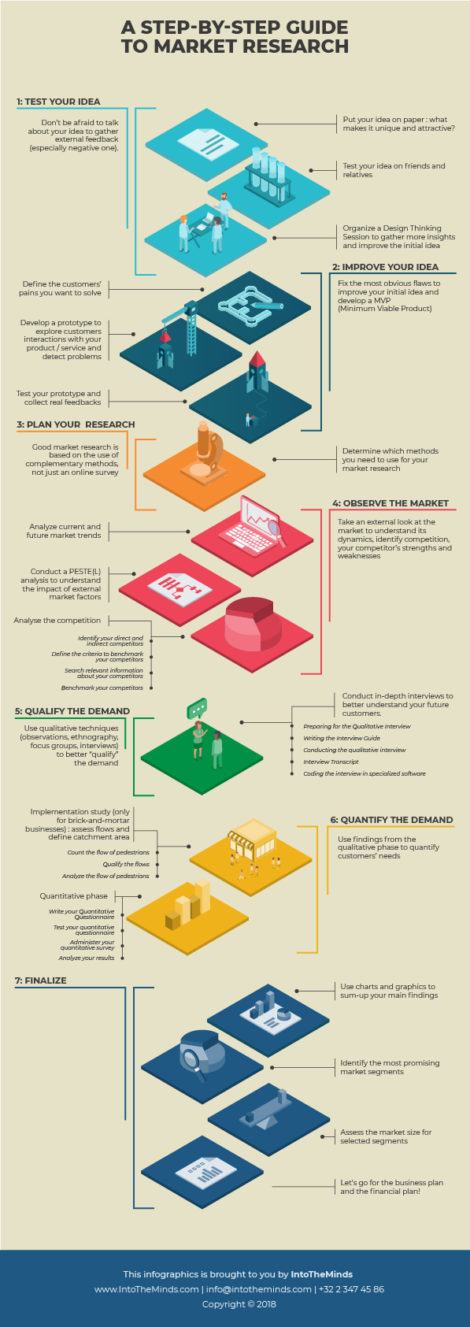

How to make a market research questionnaire? What questions to ask? When you do market research, the questionnaire is a must. So much so that questionnaires and market research are often used interchangeably. However, it is only one step in a complete process that allows you to get closer to the truth of the market. In this article, we address all these issues and propose complete examples in B2B and B2C to download.
For more real-life examples, we refer you to the website etude-de-marche.online, where we list and comment on the questionnaires we find online. You can also find our guide to writing your questionnaire here.

Questionnaires and market research have become synonymous. However, they are not. The quantitative questionnaire is one market research method among others.
Understanding a market involves approaching it from several angles. Classically, market research is done in 3 phases:
To know more about the market research process, visit our free online guide. You can browse the right infographic, representing the global method we have conceptualized. The questionnaire section is #6.
Most questionnaires are now administered in the form of online surveys. As far as our market research firm is concerned, we have to admit that it has been a long time since a customer asked us to conduct a face-to-face administration (on the street, for example) or by post.
We advise our customers never to exceed 10 minutes and 25-30 questions. This avoids problems such as:
Two examples to download are waiting for you at the end of this article.
Questionnaire and market research are too often considered interchangeable terms.
In this paragraph, we propose to go through the ideal structure of a market research questionnaire:
Your questionnaire can start with a short introduction presenting the purpose of the market research. It should not be too long but clear enough for the respondent to understand:
In B2C and B2B, some themes are almost always present in all market research questionnaires. There are 5 of them:
As you can see, these questions follow a certain logic. You will first check that the respondent has the right profile to answer (screening), then ask them about their buying habits (the current situation) before moving on.
We propose the following table to give you an overview.
| Type of question | Objective | Recommended number of questions | Point of interest | |
| 1 | Screening | Check that the respondent has the right profile | 1-3 | Avoid overly intrusive questions. Use only factual questions. |
| 2 | Buying habits | Understand the current habits and the solutions used to satisfy the respondent’s needs and possibly obtain information on known competitors. | 5 | Don’t get lost in the details. Focus on the most important aspects of the respondent’s habits, those that will impact you. |
| 3 | Needs | Projecting into the sources of dissatisfaction and perceived needs (pains). | 4-8 | This part is very important because it allows you to collect essential information that you can use to improve your product/service. |
| 4 | Buying intentions | Test the respondent’s interest in your product/service | 2-4 | The control variables will allow you to create customer segments based on their interest. Your go-to-market strategy can then be based on them. |
| 5 | Pricing | Find the ideal pricing or test the respondent’s interest at several price levels | 2-4 | Testing pricing is a very delicate exercise. Many biases can taint your results. Avoid testing several price levels with the same respondent. Prefer a “2×2 in between” design. |
You will finish your questionnaire by asking questions about the respondent’s profile. Age, sector of activity, gender, etc., are all variables that will allow you to cross-reference the results and better segment your target population. Here is a non-exhaustive list of the control variables we use most often in our research.
B2B (for products or services sold to companies):
B2C (for products or services sold to individuals)
In a B2B context, a market research questionnaire must undergo certain adaptations.
These concern, of course, the questions on the respondent’s profile. Demographic aspects are little important in B2B. However, the hierarchical position, the company’s size, and its sector of activity must be recorded.
Above all, the questions asked will be different. You will probably have to ask more questions to determine the company’s current practices and gather information on the competition. In this respect, B2B market research will also be interested in the price currently paid by the company if it already has a competing solution. In a B2C context, this price aspect may be less important, especially if it is a regular purchase. Do you remember the price of everything you buy in the supermarket as a consumer?
In the B2B context, you will also have to put more emphasis on decision-making. In B2C, the consumer decides alone most of the time. In B2B, this is never the case because there are procedures to follow within any company.
The questionnaire below concerns research on car purchases by individuals. It is, therefore, B2C market research. It includes 26 questions. You can find the internal instructions (in blue) that we put to check that the programming of our questionnaire is correct.
The questionnaire you will find below concerns research on hygiene in companies. It is therefore intended for a professional audience. You will note that we have provided an explanatory text (in blue) for some questions. This is a good practice when the question is complicated or needs to be contextualized.
Many examples of market research questionnaires are available on our dedicated website, www.etude-de-marche.online. You can find the complete questionnaire, all the questions, and our explanations and reviews in the video.

IntoTheMinds is a market research firm and marketing consultancy located in France (Paris) and Belgium (Brussels).
Belgium
France
Italy
Copyright © IntoTheMinds 2013 - 2024, all rights reserved Gérer le consentementPour offrir les meilleures expériences, nous utilisons des technologies telles que les cookies pour stocker et/ou accéder aux informations des appareils. Le fait de consentir à ces technologies nous permettra de traiter des données telles que le comportement de navigation ou les ID uniques sur ce site. Le fait de ne pas consentir ou de retirer son consentement peut avoir un effet négatif sur certaines caractéristiques et fonctions.
Fonctionnel Fonctionnel Always activeLe stockage ou l’accès technique est strictement nécessaire dans la finalité d’intérêt légitime de permettre l’utilisation d’un service spécifique explicitement demandé par l’abonné ou l’utilisateur, ou dans le seul but d’effectuer la transmission d’une communication sur un réseau de communications électroniques.
Préférences PréférencesLe stockage ou l’accès technique est nécessaire dans la finalité d’intérêt légitime de stocker des préférences qui ne sont pas demandées par l’abonné ou l’utilisateur.
Statistiques StatistiquesLe stockage ou l’accès technique qui est utilisé exclusivement à des fins statistiques. Le stockage ou l’accès technique qui est utilisé exclusivement dans des finalités statistiques anonymes. En l’absence d’une assignation à comparaître, d’une conformité volontaire de la part de votre fournisseur d’accès à internet ou d’enregistrements supplémentaires provenant d’une tierce partie, les informations stockées ou extraites à cette seule fin ne peuvent généralement pas être utilisées pour vous identifier.
Marketing MarketingLe stockage ou l’accès technique est nécessaire pour créer des profils d’utilisateurs afin d’envoyer des publicités, ou pour suivre l’utilisateur sur un site web ou sur plusieurs sites web ayant des finalités marketing similaires.